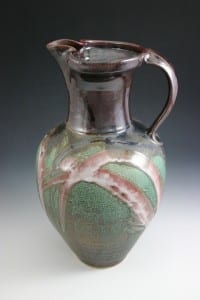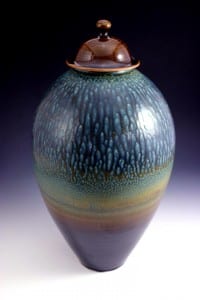The Nutting Gallery at West Liberty University will present an exhibition that looks at pottery in its “WV Mud Show,” Feb. 19-March 21, 2013. The exhibition features clay work by two of West Virginia’s finest potters, Gary Shaffer and Kurt Teeter, according to Robert Villamagna, Nutting Gallery director and assistant professor of art.
It will open with a reception from 5:30- 7 p.m., Tuesday, Feb. 19. Both the exhibition and the reception are free and open to the public.
Shaffer lives and works in Brooks, W.Va., located in the New River National River area. He produces high-fired stoneware and porcelain pottery, mostly wheel thrown, and fires reduction cone 10 in three kilns – one for glaze ware, one for salt firing and the third for wood firing.
Shaffer began making pottery in a high school program in Wellsburg, W.Va., and went on to Glenville State College studying ceramics under Charles Scott. Upon graduation, Shaffer taught junior high and high school art and mathematics in Wirt County, W.Va. In 1982 he began making pottery on a full-time basis.
Functional pottery is the focus of Shaffer’s work. It is where he has always found great satisfaction. Using a wide variety of glazes and brushwork designs, he sometimes refers to himself as a “multiple personality potter.” Shaffer does not hesitate to jump into new techniques in clay. Slip-decorated salt fired ware and large, sculptural wood-fired vases and lidded jars are major current interests. These wood-fired pieces are thrown and altered using just the hands and sculpted into their final shape by pushing in and out on the clay. The result is a dramatic yet harmonious piece expressing grace in movement.
Shaffer is a frequent juror for the Tamarack Art Center, Beckley, W.Va., and has been involved in the artist-mentoring program there. He also participates in local education in the arts efforts, as well as local arts councils. He also helped build the wood-fire train kiln located at Concord University.
He attends workshops or conferences each year, finding inspiration and enjoyment discussing technique, art and lifestyle with ceramic artists from all over the world. For more than 30 years he has exhibited his work at regional fairs and festivals including, Mountain State Art & Craft Fair in Ripley, W.Va., Waterford Home Tours and Craft Demonstrations in Waterford, Va., Augusta Heritage Festival in Elkins, W.Va. and the Vandalia Gathering at the State Capital in Charleston, W.Va. His work can be found at Tamarack, the Charleston Cultural Center, Plants, Etc. in Lewisburg, W.Va., and the Artisan Shop at Pipestem State Park.
His recent gallery exhibitions include Best of West Virginia Juried Exhibition, Cynthia Bickey Art Gallery, West Virginia Potters Show in Pittsburgh, West Virginia Art & Craft Guild Competition and Vasefinder.com International Exhibition. Recent awards include Tamarack Foundation Artisan Fellowship, Best of West Virginia Juried Exhibition (Second Place), Vasefinder.com International (Third Place), Mountain State Fair (Best of Show), West Virginia Guild Competition (Award of Merit).
Shaffer also enjoys working with wood a month or two each winter. He has built his own kitchen cabinets from local cherry wood and has made several musical instruments: guitars, mandolins, bouzoukis and mountain dulcimers. In 2012 he began carving wooden spoons, knives and spreaders, spatulas, soup and gravy ladles and salad sets.
Teeter was born in Keene, N.H., and raised in Provo, Utah. He received his Bachelor’s of Fine Arts from Utah Valley University in 2007, where he studied under Joseph Germaine, Mark Talbert and Brian Jensen. From the advice of his mentors he attended West Virginia University and attained his Masters of Fine Arts degree in May 2011.
In 2008, he received a grant through the Luce Foundation to study in Jingdezhen, China for the Fall Semester. In 2009, he assisted Professor He Chinese visiting artist Professor He on a stone sculpture for the upcoming West Virginia University art museum. He also received the Global Education Opportunities Grant through West Virginia University to study Talavera ceramics in Guanajuato, Mexico.
Teeters’ work has been shown throughout the United States in juried exhibitions and invitational exhibitions. He also exhibited his work in Jingdezhen, China during his study abroad in 2008.
Currently, he is working with Susan Ting at Zenclay in Morgantown, W.Va. as a studio manager and resident srtist. At Zenclay he teaches the art of ceramics to people who look to the arts as a release from the everyday tasks. He also organizes exhibitions in the three galleries at Zenclay.
“Utilitarian pottery is about connection. Pottery connects us to our daily needs through a means of service. A cup serves as a vessel to partake essential to life liquids, a casserole serves as a vessel to share a cooked meal with family or friends, and a pitcher serves the purpose of serving others with drink. These aspects of servitude and connection are why I feel pottery is so important in our contemporary culture where the digital revolution has all but taken many of these connecting aspects of life from our existence,” Teeter stated.
“My pottery is a canvas that is separated into two different facets; first, the facet of floral, second, the facet of pattern. Both of these styles offer something different in the means of rendition, yet both have a common aspect of life and our daily routines. The floral work is derived from Chinese Qinghua (cobalt oxide and white porcelain) to characterize vitality and life that we strive for as a species. I use but a piece of the peony from these Ming Dynasty Chinese pots to characterize these aspects of life.”
“The patterned facet is based on repetition of similar geometrical shapes. I find that repetition of pattern is associated with daily routines. I find that we all have some sort of routine in our daily lives: the way we begin our day, the route we take to work, or the means of entertainment in the evening. Pots fit into this idea as they are the objects that hold our routine consumable needs in daily life.”
“My work continues to change as I change. My work is my timeline that shows my feelings, my attitude and my dedication to the concept of artist. The day my work becomes repetitive in execution of the same idea over and over is the day I am no longer creative as an artist. I am not who or what I was three years ago, and I hope that I am not the same person 40 or 50 years from now. My work will continue to be a progression of my development, not only as a ceramic artist, but as a person over the course of my life.”
The Nutting Gallery is located in the Hall of Fine Arts. Gallery hours are 8:30 a.m.-2:30 p.m., Monday through Friday. Hours for weekends and other times are by arrangement only. For more information, please contact Villamagna at rvillama@westliberty.edu or 304.336.8370.


